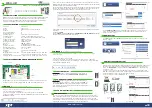DRAFT
DRAFT DRAFT DR
DRAFT DRAFT DRAFT
D
RAF
DRAFT DRAFT DRA
FT D
RAFT DR
AFT D
DRA
FT DRAFT DRAFT
D
RAFT
DRAFT
D
RAFT
DRA
UM10601
All information provided in this document is subject to legal disclaimers.
© NXP B.V. 2012. All rights reserved.
Preliminary user manual
Rev. 1.0 — 7 November 2012
38 of 313
NXP Semiconductors
UM10601
Chapter 4: LPC800 System configuration (SYSCON)
4.7 Functional description
4.7.1 System PLL functional description
The LPC800 uses the system PLL to create the clocks for the core and peripherals.
The block diagram of this PLL is shown in
. The input frequency range is 10 MHz
to 25 MHz. The input clock is fed directly to the Phase-Frequency Detector (PFD). This
block compares the phase and frequency of its inputs, and generates a control signal
when phase and/ or frequency do not match. The loop filter filters these control signals
and drives the current controlled oscillator (CCO), which generates the main clock and
optionally two additional phases. The CCO frequency range is 156 MHz to 320 MHz.
These clocks are either divided by 2
P by the programmable post divider to create the
output clocks, or are sent directly to the outputs. The main output clock is then divided by
M by the programmable feedback divider to generate the feedback clock. The output
signal of the phase-frequency detector is also monitored by the lock detector, to signal
when the PLL has locked on to the input clock.
Table 38.
Device ID register (DEVICE_ID, address 0x4004 83F4) bit description
Bit
Symbol
Description
Reset value
31:0
DEVICEID 0x0000 8100 = LPC810M021FN8
0x0000 8110 = LPC811M001FDH16
0x0000 8120 = LPC812M101FDH16
0x0000 8121 = LPC812M101FD20
0x0000 8122 = LPC812M101FDH20
part-dependent
Fig 4.
System PLL block diagram
/2&.
'(7(&7
3)'
)&/.287
SG
DQDORJVHFWLRQ
SG
FG
0
3
FG
36(/!
SG
06(/!
LUFBRVFBFON
V\VBRVFBFON
&/.,1
6<63//&/.6(/
)&/.,1
)&&2
/2&.


















